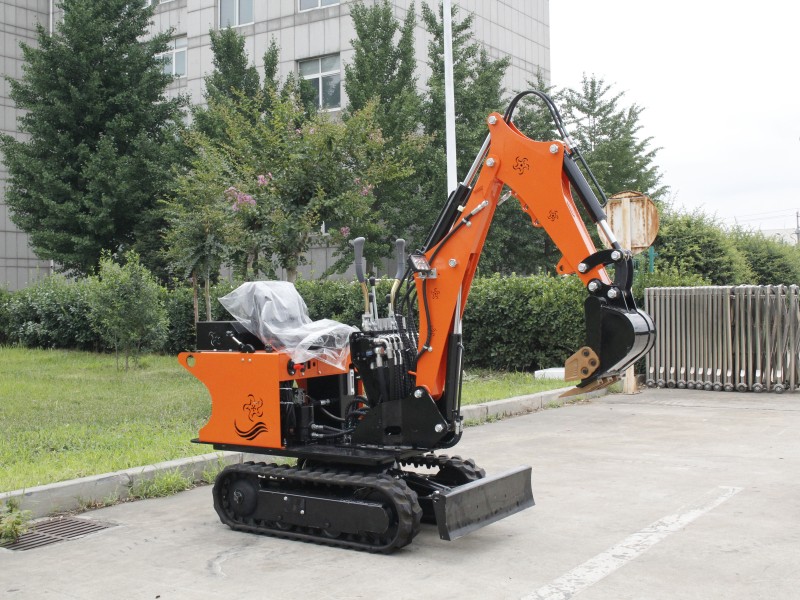When purchasing a small excavator,width is one of the key parameters that many users care about.The width of a small excavator directly determines whether it can operate flexibly in a narrow space,especially in urban construction,landscaping and other working conditions that require high mobility.The width of the equipment is particularly important.Whether it is the space limitation of the construction site or the convenience in transportation,the width of the small excavator has become an important consideration for users when choosing.Therefore,understanding the width of the small excavator helps us better choose equipment that suits our work needs.
Generally speaking,the width of a small excavator is usually between 1 meter and 2 meters,but the specific width varies depending on the brand,model and design requirements.The width of common small excavators is mostly concentrated between 1.2 meters and 1.8 meters.This size enables them to flexibly cope with narrow working environments,such as street reconstruction,underground pipeline laying,and house foundation engineering.This type of project has strict requirements on the passability of the equipment,so it is crucial to choose a small excavator with the right width.
In actual use,small excavators with smaller widths have higher mobility and can enter narrow spaces that some large equipment cannot enter for operation.Small excavators with slightly larger widths perform better in terms of stability and digging force,and are suitable for working conditions where the space is relatively spacious but large equipment is not required.Therefore,understanding the differences in performance of small excavators of different widths is crucial to choosing the right equipment.
Small excavators with a width of less than 1 meter are ultra-small equipment,usually called"micro excavators".The advantage of this type of excavator is its extremely high flexibility,which is very suitable for use in scenarios with extremely high space requirements such as home courtyards,small greening projects,and indoor renovations.Although the micro excavator is small in size,it still retains the core functions of the excavator,and the digging depth and bulldozing capacity can also meet the needs of lightweight projects.For situations where the construction site is small and turning is difficult,the width of this type of small excavator often becomes a decisive advantage.
Small excavators with a width of 1.2 meters to 1.8 meters are the mainstream products on the market.While maintaining a compact body,this type of equipment has both strong digging force and stability.They are widely used in scenes such as urban infrastructure construction,road maintenance,and farmland operations.Especially today when urbanization is accelerating,many renovation projects in old urban areas need to be constructed in narrow alleys,and these small excavators with moderate width can easily complete the task without damaging the surrounding environment.It is worth noting that the performance of the width of the small excavator in construction not only affects the passability,but is also directly related to the operating radius,stability and safety of the equipment.
Although small excavators with larger widths are not as good as ultra-small excavators in terms of passability,they are more stable during operation,especially when facing rugged terrain.The increase in width means that the ground contact area ofthe equipment track is expanded,providing better traction and grip,thereby improving the efficiency and safety of the operation.For scenes such as farmland reclamation and rural road construction,small excavators with a width of more than 1.6 meters are usually ideal.
In addition,the width of different small excavators also affects the transportation and storage of equipment.Models with narrower widths are more convenient to transport,and many small trucks can easily carry them;while models with larger widths have higher transportation requirements,but their performance in construction efficiency can make up for this inconvenience.Therefore,when purchasing,it is necessary to comprehensively consider the construction needs and transportation conditions and reasonably choose a suitable small excavator.
When purchasing a small excavator,in addition to the width,we should also pay attention to other parameters of the equipment,such as digging depth,bucket capacity,engine power,etc.These factors work together with the width to determine the overall performance of the excavator.For example,although an excavator with a smaller width is flexible,it may slip on soft ground due to its narrow crawler during operation.Therefore,when choosing,it is necessary to comprehensively evaluate various parameters according to the working conditions.
In general,the width of a small excavator is one of the important factors that determine its applicable scenarios.For narrow space operations,the smaller the width,the better,which can effectively improve the flexibility of the operation;in situations where greater stability and operating efficiency are required,it is more reasonable to choose an excavator with a moderate width.According to specific construction needs,the reasonable selection of width is the key to ensuring the high-efficiency operation of small excavators.By comparing small excavators of different widths,we can find the equipment that best suits our working conditions and help the project go smoothly.
